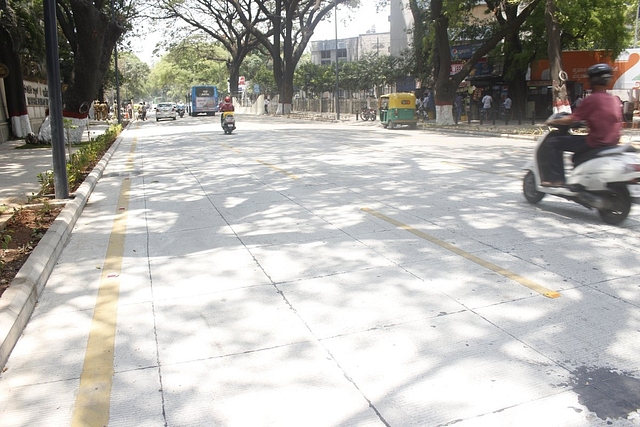
Why Bengaluru Must Go For High-End Black Roads, And Not White-Top Them
Since work on most utilities are still underway, concreting roads is not a good idea, as they have to be dug up all over again.
Concrete roads are preferred in areas with high-rainfall, so why is the city after white roads?
The second instalment of Bengaluru’s frenzy with white-topped roads began earlier this month with several crucial roads such as Hosur Road and Outer Ring Road being partially closed in order to get the work done. These two roads were among the 29 roads across the city that the Bruhath Bengaluru Mahanagara Palike (BBMP) decided to proceed with in a bid to rid the Information Technology (IT) capital of its potholes that had lately become an icon on the city’s roads.
However, the work didn’t proceed as smoothly as expected, throwing the city’s already chaotic traffic further off gear. So bad were the traffic snarls that the BBMP ultimately decided to suspend the work except on Outer Ring Road. This isn’t the first time that transport infrastructure projects have been put on hold or suspended, however. Four underpass projects were scrapped after work had begun on Sarjapur Road in 2011 after residents in the area protested.
So What Exactly Are White-Topped Roads?
White-topped roads refer to a thin layer of concrete that is laid over existing asphalt roads. Since concrete tends to be more durable, it is virtually impervious to the kind of damage that an asphalt or bituminous road surface would undergo due to wear and tear. This reduces their cost of maintenance post construction to virtually zero and at the same time increases the lifespan of the road. The average life of a concrete road is expected to be around 40 years compared to the 10 years that an asphalt road is supposed to have.
The city first went in for white-topped roads in 2010 when the BBMP tried it out on a section of Hosur Road between the Madiwala Underpass and St John’s Hospital. The stretch of road in question was chosen for a crucial reason – lack of civic utilities like cables and pipelines below the road at this section.
This brings us to a crucial point that we must remember. Concrete roads cannot be dug up easily. Therefore, utilities need to either be shifted or ducts must be built below the road surface in order to access them.
But Why Concrete Roads?
Concrete roads are preferred for two reasons, maintenance (or the lack of it) and longevity. They are preferred in areas with high-rainfall such as Mumbai, Pune, and Mangalore. This is the same reason why India’s first expressway – the Mumbai-Pune Expressway – is made of concrete, and other roads in the region such as parts of the Mumbai-Goa-Mangalore National Highway (NH 66) which skirts the Konkan Coast.
Mumbai receives twice the amount of rainfall that Chennai receives on an average, which is still higher than what Bengaluru receives. Yet in spite of this, Chennai has very few white-topped or concrete roads. In spite of the rainfall, Chennai’s roads are of pristine quality, and have been damaged only during the floods of 2015.
The Problem With Concrete Roads In Bengaluru
Building concrete roads in Bengaluru has a deeper effect than thought of. The timing of BBMP’s actions are questionable, and not so because the state goes to vote in less than six months.
One of the sections selected, a 4.2 km section of Bannerghatta Road from Anepalya to J P Nagar, is also where the upcoming Red Line of the Namma Metro project is being built. Construction on the southern section of the line is due to start with the tender having been awarded. Thus, if the roads are white-topped, it would result in an expensive road being dug up once again.
Similarly, the government is now sending the city’s overhead power cables underground. Similarly, a bulk of the city, especially newer areas, lack a water or sewerage connection. Back in 2013, the chairman of the Bangalore Water Supply and Sewerage Board (BWSSB) had said that it would take the city at least 10 more years to get a connection to every household. The city is also in the process of setting up a piped gas line. Given that most utilities such as water supply, sewerage, piped gas, electricity, optical fibre cable, all are still underway, concreting roads before all utilities are underground is not a good idea.
While cities such as Amaravati – Andhra Pradesh’s upcoming capital city – are going for concrete roads right from the start, it makes sense for them to do so. Amaravati is a planned city being built from the scratch where getting the work done will be easier. Further, given that Amaravati is on the coast, it is bound to expect more rainfall than Bengaluru.
The Bottom Line
When Chennai manages to build good asphalt roads that can handle the heavy traffic load on the cities, why can’t Bengaluru do the same? When the National Highways Authority of India (NHAI) has managed to build good quality asphalt roads on Hosur Road, and Tumkur Road, why can’t the BBMP do the same. Funding is not a problem, given the total budget outlay for 2017-18 was Rs 9,243 crore with 45 per cent (Rs 4,118 crore) being allocated for roads.
Further, even in cities like Mumbai, several crucial roads such as the Western Express Highway (WEH) and Eastern Express Highway (EEH) are surfaced with mastic asphalt. Mastic asphalt is preferred due to its waterproofing qualities and must be seriously considered by the BBMP.
While one can assume that the white-topping is being done due to a nexus between politicians and cement manufacturers, it is advisable for Bangalore to go for high-end ‘black’ roads and not go running after the whiter ones.